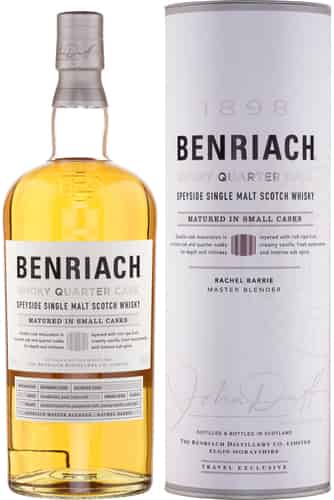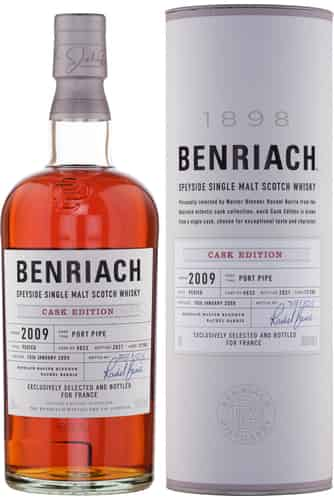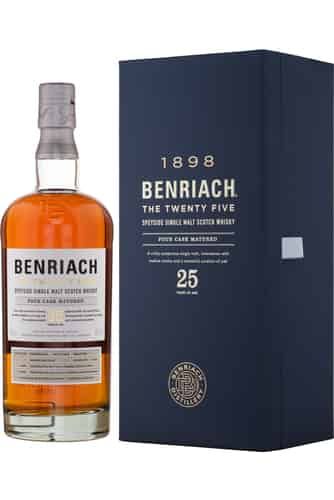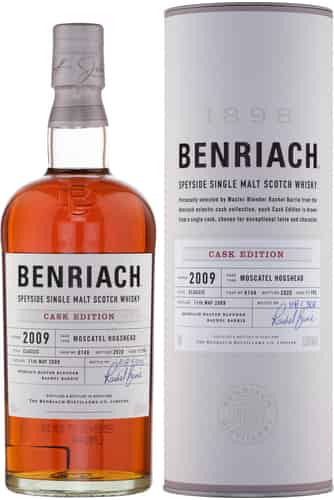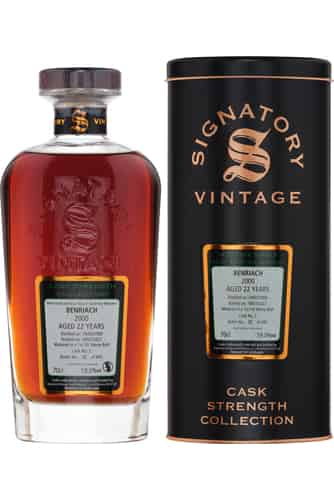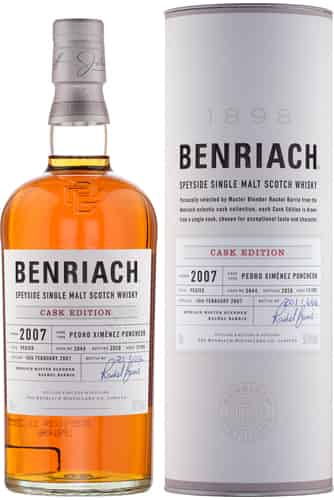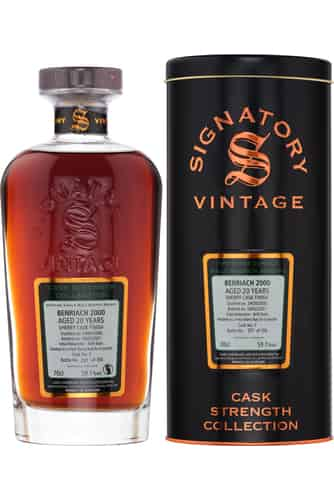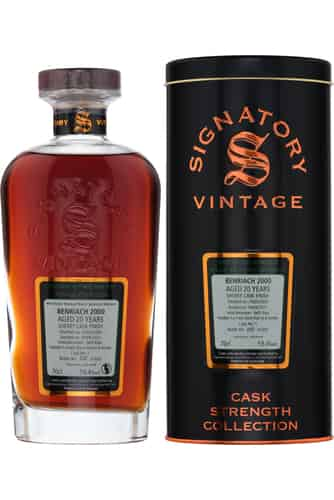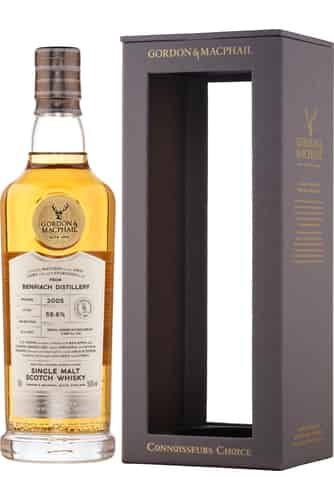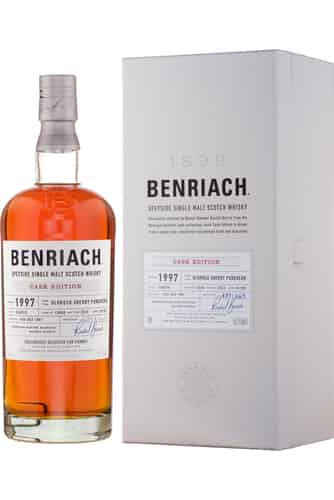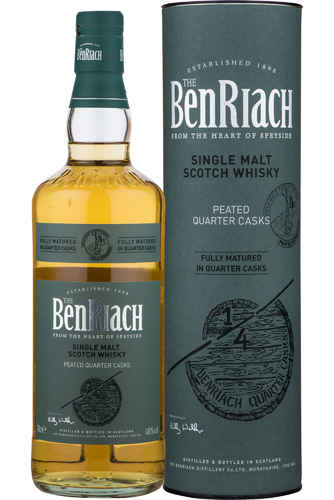 United States - DHL 15.00 € + 7.70 € /kg
United States - DHL 15.00 € + 7.70 € /kg
Benriach
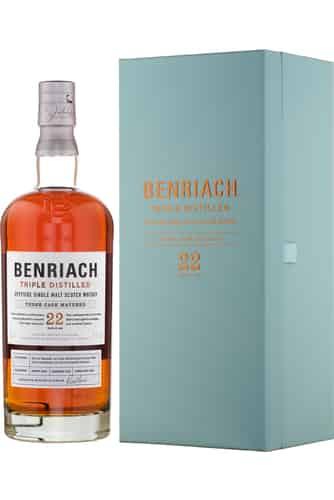
Benriach 22 Year Old Triple Distilled
70 cl, 46.8%In stock159.20 €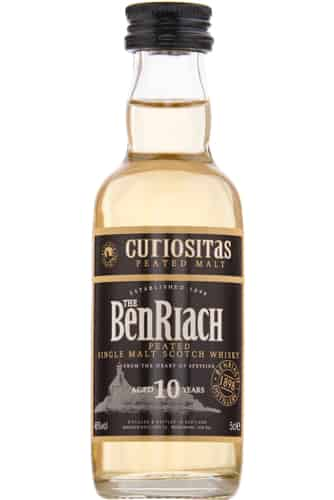
BenRiach 10 Year Old Curiositas Miniature
5 cl, 46%In stock5.60 €- Save
9.60 €![]()
Benriach Smoky Quarter Cask (1 Liter)
100 cl, 46%In stock53.60 €63.20 € ![]()
Benriach 12 Year Old 2009 Port Pipe (Cask #4832)
70 cl, 59.9%In stock111.20 €![]()
Benriach The Twenty Five 25 Year Old
70 cl, 46%In stock287.20 €![]()
BenRiach 16 Year Old
70 cl, 43%In stock76.00 €![]()
Benriach 11 Year Old 2009 Moscatel Hogshead (Cask #8748)
70 cl, 53.9%In stock111.20 €![]()
Benriach 22 Year Old 2000 (Cask #2) - Signatory Cask Strength
70 cl, 59%In stock231.20 €![]()
Benriach 13 Year Old 2007 Pedro Ximénez Puncheon (Cask #3944)
70 cl, 56.2%In stock127.20 €- Save
24.00 €![]()
Benriach 20 Year Old 2000 (Cask #3) - Signatory Cask Strength
70 cl, 59.1%In stock199.20 €223.20 € ![]()
Benriach The Smoky Ten 10 Year Old
70 cl, 46%In stock37.60 €![]()
Benriach The Twelve 12 Year Old
70 cl, 46%In stock44.00 €![]()
Benriach The Twenty One 21 Year Old
70 cl, 46%In stock159.20 €- Save
24.00 €![]()
Benriach 20 Year Old 2000 (Cask #1) - Signatory Cask Strength
70 cl, 59.4%In stock199.20 €223.20 € ![]()
Benriach The Smoky Twelve 12 Year Old
70 cl, 46%In stock48.00 €![]()
Benriach 15 Year Old 2005 (Cask #118) - Connoisseurs Choice (Gordon & MacPhail)
70 cl, 59.6%In stock116.00 €![]()
Benriach The Original Ten 10 Year Old
70 cl, 43%In stock33.60 €![]()
Benriach Smoke Season
70 cl, 52.8%In stock57.60 €![]()
Benriach 24 Year Old 1999 (Cask #63204) - Connoisseurs Choice (Gordon & MacPhail)
70 cl, 57.1%In stock240.80 €![]()
Benriach 24 Year Old 1997 Oloroso (Cask #15059)
70 cl, 55.7%In stock386.40 €![]()
BenRiach Quarter Casks
70 cl, 46%In stock60.00 €![]()
BenRiach Peated Quarter Casks
70 cl, 46%In stock53.60 €
Sorry, we didn't find anything. Please try changing your search criteria.
BenRiach History
BenRiach is one of the most interesting distilleries of the last 10 years. A true phoenix rising from the ashes, BenRiach had suffered under mismanagement and long periods of dormancy throughout their history, before the current owners revived their fortunes. BenRiach is very much a modern Speyside distillery, with expressions that represent the typical profile of the region, alongside lines that have expanded the distillery’s repertoire with peat and wine influence. BenRiach (and their owner Billy Walker) has gained a reputation for doing things "the right way," presenting expressions in a "craft" style and staying true to the distillery’s traditions.
BenRiach draws its water from the nearby Bourmade spring, unusual as it is fairly hard water with a high percentage of minerals, yet this is all part of the whisky’s character. They previously had their own malting floors, though this was mothballed in 1999. Luckily, the floor maltings were kept in very good condition, and BenRiach began using them again in 2012. They use a traditional cast iron mashtun, with a 5.8 tonne charge of grist and 16 mashes per week. They water their mash four times at a fairly low temperature, which, when combined with the hard water, contributes to BenRiach’s light profile.
30,000 litres are produced by each mash, and these are transferred to eight stainless steel washbacks (until a refurbishment in 1977 BenRiach used wooden washbacks). Fermentation takes up to four days at BenRiach, and is said to add a green apple note to the final product. The beer is then transferred to BenRiach’s stills.
For a long time, the distillery operated a strange system with one wash still and one spirit still, and a third still that was occasionally used for triple distillation. This changed in 1985 when BenRiach moved to four stills, though the old third still was removed in 1998. Some whisky is still tripled distilled with every batch.
The stills themselves are quite tall, with a shallow decline on the lyne arm, keeping the spirit light. The two wash stills have a capacity of around 21,000 litres, though they are usually charged twice with 15,000 litres. The spirit still has a capacity of just shy of 13,000 litres, but is charged to about 10,000 litres. BenRiach tends to take a middle cut of two hours, with a bottom ABV of 60.5% which is unusually low, and they push this even lower for their peated whisky. The new make averages 67% however, and is casked at the industry standard 63.5%.
BenRiach’s recent experiments with peated whiskies have drawn some criticism from so-called "purists" who don’t think that a Speyside distillery should stray into what they consider the realms of Islay whiskies. These critics fail to realise that Speyside distilleries have historically used peat in their whiskies, and BenRiach is producing a malt of real quality. Nevertheless, peated whisky now makes up a fair part of their production, at around 200k litres of the 1.2m they produce annually.
The warehouse situation at BenRiach is an interesting one, with them still shared with both Longmorn and the previous owners Chivas. All warehouses are earthen floor with dunnage storage, and hold around 28000 casks. Some of the oldest whisky there dates back to 1966, and there are also casks of the triple distilled whisky still maturing. BenRiach has become known for its interesting cask finishes, including usual choices like Rum and Virgin Oak.
The history of this distillery has been largely a sad one, with prolonged periods of closure and financial mismanagement. Immediately after being constructed by John Duff, who had previously founded the Longmorn distillery the year before, financial difficulties meant that Duff had to sell both institutions. The Longmorn Distillery co. then purchased the distillery, but immediately closed it in 1900. It would remain silent for over half a century. The Glenlivet Distillers Ltd. then purchased the distillery and rebuilt it in 1965.
Seagram took ownership 1977, who expanded the stills. Finally, in 1994 an official bottling was released, a fairly standard 10 year old Speysider. The distillery was then sold to Chivas, in 2001, who (like many before them) closed it after just a year. Finally, in 2004, the distillery got the ownership it deserved, when Billy Walker and two South African partners took control. Very quickly they transformed the brand, changing the labelling and adding the capital "R" in the name. In less than ten years, they took a distillery that was perennially on the brink, and turned it into one of the hottest distilleries of the new millennium. They would later repeat the trick with GlenDronach.
Current Range
BenRiach has one of the widest ranges of whisky available. This extends from an entry level 10 year old, alongside a Non Age Statement "Heart of Speyside", to 20 and 25 year old premium expressions. Along the way there are many interesting cask finishes, mostly with an age statement of at least 15.
Noteable Releases
Benriach has a very good track record of single cask releases. Particularly good amongst these are the whiskies from casks filled in the 70s, from before the Seagrams refurbishment when the distillery still used wooden washbacks. Much of this whisky is triple distilled, giving it an unusual and pleasing character. Younger single casks are released too, and these are also excellent. Yet there are gems to be found right there in the standard range, with the Solstice port finished expression being very well thought of, as is the 25 year old. Independent Bottlings from the likes of Blackadder and Signatory often do well too.
Did You Know?
- Down to every scratch and dent, the stills at BenRiach are supposedly exact replicas of that first graced the still house in 1898.
- Whilst the distillery itself was silent for many years, the floor maltings only stopped working in 1999, as they spent the whole period producing malted barley for the nearby Longmorn distillery.
- Not content with working one whisky miracle, Billy Walker & Co. acquired GlenDronach, and revived their fortunes too, producing many excellent whiskies. They have recently bought GlenGlassaugh- so watch this space!
- In addition to this, the "BenRiach Group" as they are now known, were granted a £27million loan from the Royal Bank of Scotland. This has seriously put them in the big leagues alongside the likes of Diageo and Remy, meaning that there may be a lot more to come from this ambitious group of distillers and managers.

